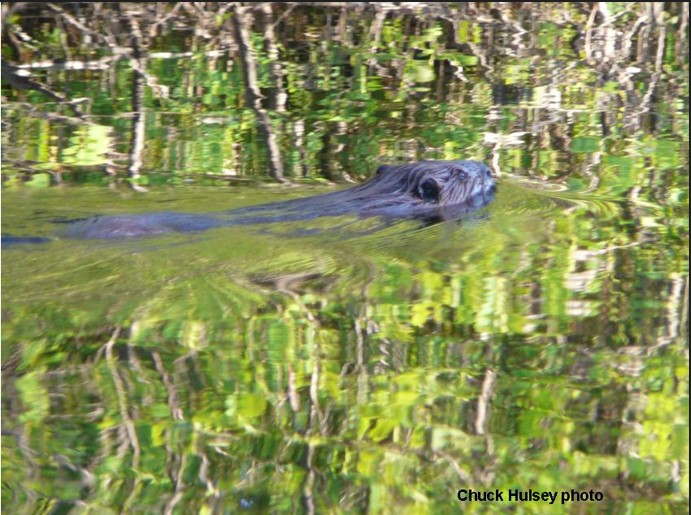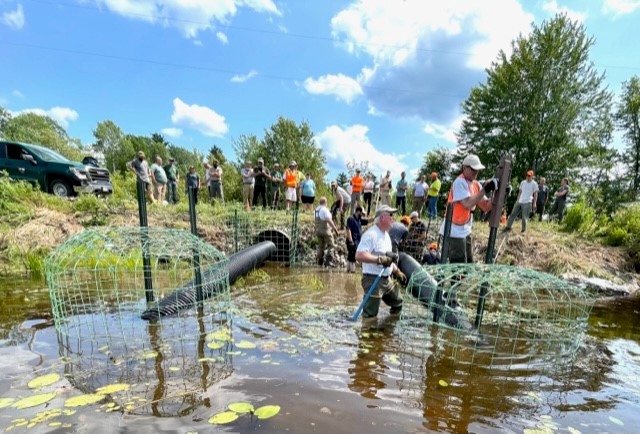August 2, 2022 at 11:32 am
Beaver are an often undervalued and underestimated species but are deemed both a keystone species and an ecosystem engineer, beavers create vital habitat that other species rely on, and often have a positive impact on other wildlife in the area. The changes that beavers cause to both living and nonliving things of the environment can help to build deeper, colder pools of water, benefiting trout and other fish, generate longer hydroperiods for amphibians, create sites for waterfowl to nest, rear broods, and stop-over to feed during long migrations, and increase the production of certain plants and aquatic vegetation that’s appealing to moose and other mammals. (Baker et al, 2003).

Despite all the positive impacts that America’s largest rodent brings to the table and the appreciation we have for them, beavers can become a problem if their eating habits or dam/den building activity floods or damages property. To learn more about the biology and ecology of beavers, and ways to live with them, Maine Department of Inland Fisheries and Wildlife (MDIFW), The U.S. Department of Agriculture (UDSA) -Wildlife Services, and the town of Dixmont partnered and held a training, open to those who might have direct or indirect involvement with beaver conflicts, to demonstrate the best ways to live with beaver.
Every spring, sub-adult beavers disperse from their home colony to find unoccupied habitat or a potential mate. In response to this, MDIFW and USDA-Wildlife Services has held three training programs over the past few years, taking advantage of the opportunity to demonstrate site modification, involving the construction of physical barriers to deny the beavers access to individual trees or culverts. The training is geared towards those who need to resolve conflicts on a regular basis as part of their work, such as animal damage control agents, wildlife biologists, foresters, and the Maine Department of Transportation (MDOT).

The hot day began inside the Etna-Dixmont school who graciously hosted more than 29 people, including Conservation Commission folks, for the morning component of the training. Participants received general historical knowledge and background of beavers to give better insight to their innate drive to build dams where water flowages exist, and a quick run-down of the types of exclusionary devices that can be implemented. Based on the cost and time-tested results of previously installed and successful exclusionary devices, often times beaver can remain in place, enhancing the habitat and enjoy a long-term solution to the problem. With some basic knowledge, the crew headed down the road to the location where they would learn through hands-on work how to develop an exclusionary device meant to keep beaver from damming a road culvert.

As participants initiated unloading materials to build the ‘beaver deceiver’, Ben Nugent from USDA-Wildlife Services, and Wildlife Biologists Chuck Hulsey and Scott Lindsay from MDIFW began providing instruction to lay out several livestock panel fencing materials on the ground and roll it into a large circle. Participants and volunteers bent the edges of the fencing to secure a top and bottom, and cut a hole for the plastic culvert, or water leveler, to fit into the cage. The longer the culvert, the more challenging it is for the beaver to determine the origin of the water flowage. Next, another section of fencing was erecting around the permanent culvert, equipped with its own hole for the additional plastic culvert, and a special turtle passage; big enough for turtle exit or entry, but small enough to keep a busy beaver excluded. Over a couple of hours, the beaver deceiver took shape, and thanks to the hands of many, a long-term and meaningful solution was provided to the residents of Dixmont by ‘treating a plugged road culvert as a water problem, not a beaver problem, making the beaver irrelevant’ as the long ago MDIFW Wildlife Technician Jimmy Dorso would say.

A big thank you to the town of Dixmont, the Etna-Dixmont School, and volunteers who made the road-ways safe while the participants worked!

Baker, B. W., and E. P. Hill. 2003. Beaver (Castor canadensis). Pages 288-310 in G. A. Feldhamer, B. C. Thompson, and J. A. Chapman, editors. Wild Mammals of North America: Biology, Management, and Conservation. Second Edition. The Johns Hopkins University Press, Baltimore, Maryland, USA.